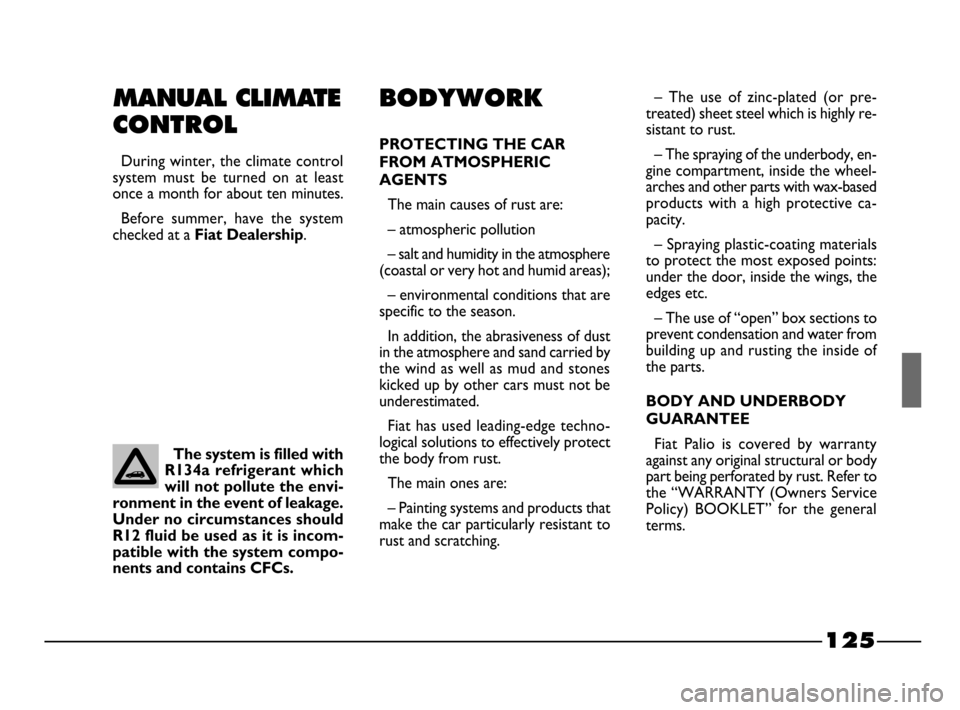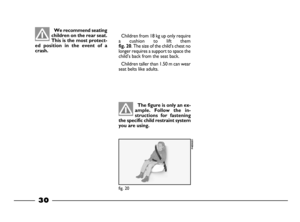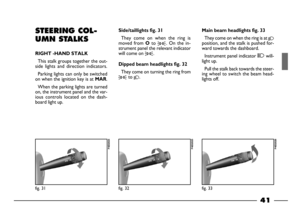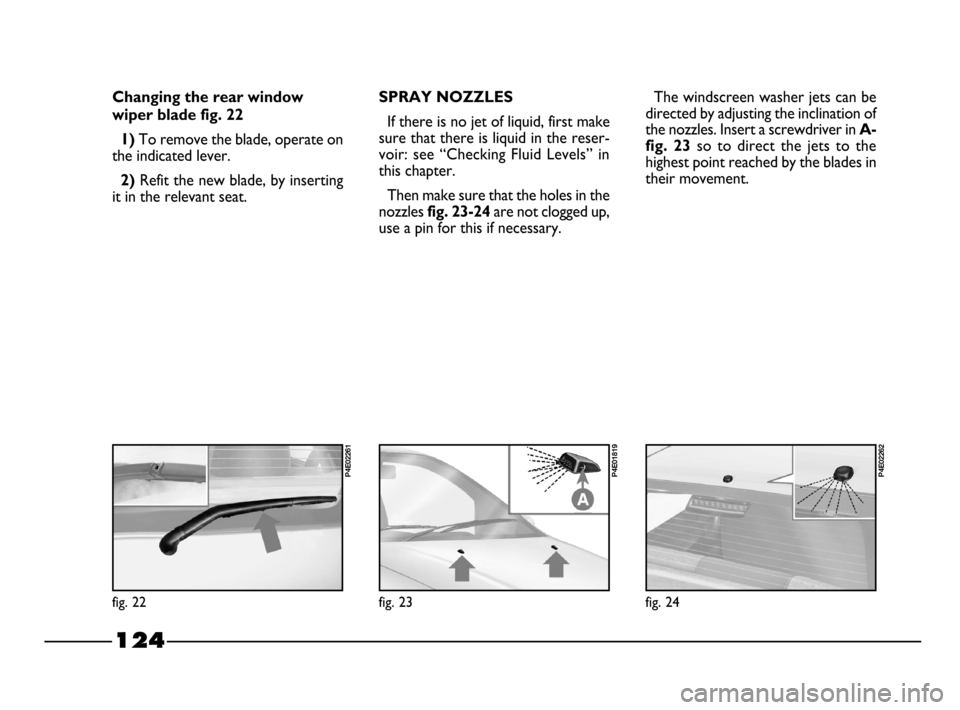Page 121 of 156

IMPORTANT If the sound system
or car alarm systems are not installed
correctly, they can interfere with the
working of the electronic control
units.
Modifications or repairs
to the electrical system
carried out incorrectly
and without bearing the features
of the system in mind can cause
malfunctions with the risk of fire.
120
ELECTRONIC
CONTROL UNITS
When the car is being used normal-
ly, special measures are not necessary.
The following instructions must be
followed very carefully however, if you
work on the electrical system or
where emergency starting is neces-
sary:
– Never disconnect the battery from
the electrical system while the engine
is running.
– Disconnect the battery from the
electrical system if you are recharg-
ing it. Modern battery chargers can
discharge voltage up to 20 V.
– Never perform emergency star-
tups with a battery charger. Always
use an auxiliary battery (see “Startup
with auxiliary battery” in “In an emer-
gency” chapter).– Be particularly careful when con-
necting the battery to the electrical
system. Make sure that the polarity is
correct and the connection is efficient.
After reconnecting the battery, the in-
jection/ignition control unit will need
to readapt its internal parameters.
Therefore, the car’s performance may
change slightly during the first few kilo-
meters.
– Do not connect or disconnect the
terminals of the electronic units while
the ignition key is at
MAR.
– Do not check polarity through
sparking.
– Disconnect the electronic units if
you are electrically welding the car
body. Remove the units if tempera-
tures exceed 80°C (special operations
on the bodywork etc.).
104-127 03/03/2003 06:53 PM Page 120
Page 122 of 156

121
SPARK PLUGS
The cleanness and soundness of the
spark plugs
fig. 19 are very important
for keeping the engine efficient and
polluting emissions down.
The appearance of the spark plug, if
examined by an expert eye, is a good
way of pinpointing a problem even if it
has nothing to do with the ignition sys-
tem. Therefore, if the engine has prob-
lems, it is important to have the spark
plugs checked at a
Fiat Dealership.
The spark plugs must be
changed at the times
specified in the Service
Schedule. Only use the type of
plugs indicated. If the heat ratio is
less than required or the life spec-
ified is not guaranteed, problems
can arise.
Spark plug (type)
1.2
Champion RC7BMCChampion RC8BYC
1.6NGK BKR5EZ
Champion RC10YCC
Bosch FR8DE
fig. 19
P4E01444
WHEELS AND
TYRES
TYRE PRESSURE
Every two weeks and before long
journeys, check the pressure of each
tyre including the spare.
The pressure must be checked when
the tyre is rested and cold.
It is normal for the pressure to rise
when you are driving. If you have to
check or to restore the pressure
when the tyres are warm, remember
that the pressure value must be 0.3
bar above the specified value.
Tyre pressure must be
correct to ensure good
road holding.
104-127 03/03/2003 06:53 PM Page 121
Page 123 of 156

122
Do not change the tyres
over in criss-cross fashion
by moving a tyre from the
left hand side of the car to the
right and vice versa.
Wrong tyre pressure causes uneven
wear of the tyres
fig. 20:
A- Correct pressure: tyre wears
evenly
B- Under inflated tyre: shoulder
tread wear
C- Over inflated tyre: centre tread
wear. Tyres must be replaced when the
tread wears down to 1.6 mm. In any
case, comply with the laws in the
country where the vehicle is being dri-
ven.
IMPORTANT
As far as possible avoid sharp brak-
ing, screech starts etc.
Be careful not to hit the kerb, pot-
holes or other obstacles hard. Driving
over bumpy roads can damage the
tyres.
Periodically check that the tyres have
no cuts in the side wall, abnormal
swelling or irregular tyre wear. If any
of these occur, have the car seen to at
a
Fiat Dealership.
Avoid overloading your car: this can
seriously damage wheels and/or tyres.
If you get a flat tyre, stop immediately
and change it so as not to damage the
tyre, the wheel, the suspension and
the steering.
Tyres age even if they are not used
very much. Cracking of the tread rub-
ber and the side walls are a sign of age-
If the pressure is too low
the tyre overheats and
this can cause serious
damage.
fig. 20
P4E01445
ing. In any case, if the tyres have been
fitted for more than six years they
should be examined by an expert who
can judge whether they are still fit for
use. Remember to check the spare
tyre particularly carefully.
If a replacement is necessary, always
use new tyres and avoid using ones the
origin of which you are not certain
about.
If you replace a tyre, it is necessary
to check the inflation valve condition
and, as necessary, to change it too.
To ensure the front and rear tyres all
wear evenly, you are advised to change
the tyres over every 10-15 thousand
kilometres keeping them on the same
side of the car so as not to reverse the
direction of rotation.
104-127 03/03/2003 06:53 PM Page 122
Page 124 of 156

123
RUBBER TUBING
Follow the Service Schedule to the
letter as concerns supply line, power
steering and brake system rubber tub-
ing. Ozone, high temperatures and
long absence of fluid in the system can
in fact cause the hardening and crack-
ing of the pipes with possible loss of
fluid. A careful check is therefore es-
sential.
WINDSCREEN/
REAR WINDOW
WIPER
BLADES
Periodically clean the rubber part
with suitable products.
Change the blades if the rubber edge
is warped or worn out. You should in
any case change them approximately
once a year.– Remove any snow that has settled
on the glass: besides saving the blades
you will avoid straining the electric
windscreen wiper motor and causing
it to overheat.
– Do not operate the wind-
screen/rear window wipers on dry
glass.
Replacing the windscreen wiper
blades fig. 21
1)
Lift the windscreen wiper arm A
off the glass and position the blade
so as to form a 90° angle with the arm.
2) Push the blade downwards to re-
lease it from the arm
A.
3) Refit a new blade, inserting the
tongue on the proper set of the arm.
Make sure that is locked.
Travelling with worn
wiper blades is dangerous
because it reduces visibil-
ity in bad weather.
Some simple steps can reduce po-
tential damage to the blades:
– If the temperature falls to below
zero, make sure the rubber blade is
not frozen to the glass. If necessary,
free it with a de-icing compound.
fig. 21
P4E01818
104-127 03/03/2003 06:53 PM Page 123
Page 125 of 156
124
SPRAY NOZZLES
If there is no jet of liquid, first make
sure that there is liquid in the reser-
voir: see “Checking Fluid Levels” in
this chapter.
Then make sure that the holes in the
nozzles
fig. 23-24 are not clogged up,
use a pin for this if necessary.The windscreen washer jets can be
directed by adjusting the inclination of
the nozzles. Insert a screwdriver in
A-
fig. 23
so to direct the jets to the
highest point reached by the blades in
their movement.
fig. 23
P4E01819
fig. 24
P4E02262
Changing the rear window
wiper blade fig. 22
1)
To remove the blade, operate on
the indicated lever.
2) Refit the new blade, by inserting
it in the relevant seat.
fig. 22
P4E02261
104-127 03/03/2003 06:53 PM Page 124
Page 126 of 156

125
The system is filled with
R134a refrigerant which
will not pollute the envi-
ronment in the event of leakage.
Under no circumstances should
R12 fluid be used as it is incom-
patible with the system compo-
nents and contains CFCs.
MANUAL CLIMATE
CONTROL
During winter, the climate control
system must be turned on at least
once a month for about ten minutes.
Before summer, have the system
checked at a
Fiat Dealership.
BODYWORK
PROTECTING THE CAR
FROM ATMOSPHERIC
AGENTS
The main causes of rust are:
– atmospheric pollution
– salt and humidity in the atmosphere
(coastal or very hot and humid areas);
– environmental conditions that are
specific to the season.
In addition, the abrasiveness of dust
in the atmosphere and sand carried by
the wind as well as mud and stones
kicked up by other cars must not be
underestimated.
Fiat has used leading-edge techno-
logical solutions to effectively protect
the body from rust.
The main ones are:
– Painting systems and products that
make the car particularly resistant to
rust and scratching.– The use of zinc-plated (or pre-
treated) sheet steel which is highly re-
sistant to rust.
– The spraying of the underbody, en-
gine compartment, inside the wheel-
arches and other parts with wax-based
products with a high protective ca-
pacity.
– Spraying plastic-coating materials
to protect the most exposed points:
under the door, inside the wings, the
edges etc.
– The use of “open” box sections to
prevent condensation and water from
building up and rusting the inside of
the parts.
BODY AND UNDERBODY
GUARANTEE
Fiat Palio is covered by warranty
against any original structural or body
part being perforated by rust. Refer to
the “WARRANTY (Owners Service
Policy) BOOKLET” for the general
terms.
104-127 03/03/2003 06:53 PM Page 125
Page 127 of 156

126
Detergents pollute wa-
ter. For this reason, the
car must be washed in an
area equipped for the collection
and purification of the liquids
used while washing.
To wash the car properly:
1)Wash the body using a low pres-
sure jet of water.
2)Wipe a sponge with a slightly
soapy solution over the bodywork,
frequently rinsing the sponge.
3) Rinse well with water and dry
with a jet of air or a chamois leather.
When drying the car, be careful to
get at those parts which are not so
easily seen e.g. the door frames, bon-
net and around the headlights where
water can most readily collect. You
should leave the car out in the open
so that any water remaining can evap-
orate more easily.
Do not wash the car after it has been
parked in the sun or while the bon-
net is hot: it could take the shine off
the paint.Outside plastic parts must be cleaned
following the usual car washing pro-
cedure.
Avoid parking the car under trees;
the resinous substances that certain
species of tree shed dull the paintwork
and increase the possibility of rust
forming.
IMPORTANTBird droppings must
be washed off immediately and with
great care as their acid is particularly
aggressive.
Windows
Use specific window cleaners to
clean the windows. Use very clean
cloths to avoid scratching the glass or
damaging its transparency.
TIPS FOR KEEPING THE
BODY IN GOOD CONDITION
Paintwork
The paintwork is not only to make
your car look attractive but also to
protect the steel.
If the paint is scuffed or scratched
deeply you are advised to touch up as
necessary to prevent rust from form-
ing.
Only use genuine products when
touching up the paintwork (see the
“Technical Specifications”).
Ordinary maintenance of the paint-
work means washing it. The frequen-
cy you should do this depends on the
conditions and the environment the
car is driven in. For example:
– in areas with a high level of air pol-
lution;
– on roads sprinkled with road salt-
wash;
– parking under trees which drop
resin. In these cases, you should wash
your car more frequently.
104-127 03/03/2003 06:53 PM Page 126
Page 128 of 156

127
Detergents pollute wa-
ter. The car must there-
fore be washed in an area
equipped for the collection and
purification of the liquids used
while washing.
IMPORTANT
The engine com-
partment should be washed while the
engine is cold and with the ignition key
at
STOP. After washing make sure
that the various protections (e.g. rub-
ber boots and various guards) have
not been removed or damaged.
IMPORTANTTo prevent damage
to the electric heater element, wipe the
inside of the heated rear window gen-
tly in the same direction as the ele-
ments.
Engine compartment
At the end of each winter season,
carefully clean the engine compart-
ment. Have this done at a garage.
INTERIORS
Periodically check that water has not
collected under the mats (from dip-
ping shoes, umbrellas etc.) which could
cause the steel to rust
CLEANING SEATS AND
FABRIC COMPONENTS
– Remove dust with a soft brush or
vacuum cleaner.
– Brush the seats with a damp
sponge with water and a neutral soap.
Never use flammable
products (petroleum
ether or petrol) to clean
the inside of the car. Electro-
static charges generated by rub-
bing while cleaning could cause
fires.
Do not keep aerosol
cans in the car. There is
the risk they might ex-
plode. Aerosol cans must never
be exposed to a temperature
above 50°C; when the weather
starts to get hot the temperature
inside the car might go well be-
yond that figure.
PLASTIC PARTS INSIDE THE
CAR
Use special products designed not to
alter the appearance of the compo-
nents.
IMPORTANTDo not use alcohol
or petrol to clean the glass of the in-
strument panel.
104-127 03/03/2003 06:53 PM Page 127
 1
1 2
2 3
3 4
4 5
5 6
6 7
7 8
8 9
9 10
10 11
11 12
12 13
13 14
14 15
15 16
16 17
17 18
18 19
19 20
20 21
21 22
22 23
23 24
24 25
25 26
26 27
27 28
28 29
29 30
30 31
31 32
32 33
33 34
34 35
35 36
36 37
37 38
38 39
39 40
40 41
41 42
42 43
43 44
44 45
45 46
46 47
47 48
48 49
49 50
50 51
51 52
52 53
53 54
54 55
55 56
56 57
57 58
58 59
59 60
60 61
61 62
62 63
63 64
64 65
65 66
66 67
67 68
68 69
69 70
70 71
71 72
72 73
73 74
74 75
75 76
76 77
77 78
78 79
79 80
80 81
81 82
82 83
83 84
84 85
85 86
86 87
87 88
88 89
89 90
90 91
91 92
92 93
93 94
94 95
95 96
96 97
97 98
98 99
99 100
100 101
101 102
102 103
103 104
104 105
105 106
106 107
107 108
108 109
109 110
110 111
111 112
112 113
113 114
114 115
115 116
116 117
117 118
118 119
119 120
120 121
121 122
122 123
123 124
124 125
125 126
126 127
127 128
128 129
129 130
130 131
131 132
132 133
133 134
134 135
135 136
136 137
137 138
138 139
139 140
140 141
141 142
142 143
143 144
144 145
145 146
146 147
147 148
148 149
149 150
150 151
151 152
152 153
153 154
154 155
155






